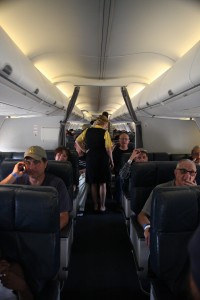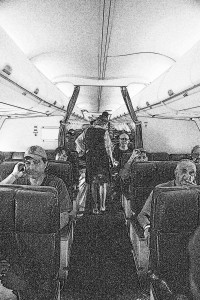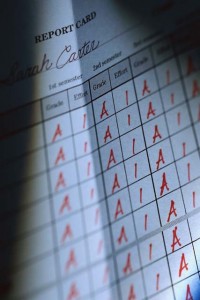
1. Where is this picture taken?
This picture is taken on a plane.
2. What are the people doing?
The people are sitting on a plane, getting ready for takeoff.
3. Who is the woman in the middle of the picture?
The woman in the middle of the picture is a stewardess, or flight attendant.
4. What is her job?
Her job is to help the passengers during the flight, so they have a pleasant journey.
5. Where do you think the people are going?
Maybe some people are going on vacation, or perhaps on a business trip.
6. What are the storage spaces over the people’s heads?
The storage spaces over the people’s heads are called overhead compartments.
7. What can you put in that storage space?
You can put carry on baggage in the overhead compartments.
8. What do you need to get on a plane?
To get on a plane you need a ticket. After you have checked in and shown your ticket to the person at the airline counter, you will get a boarding pass, which you will need to get on the plane.
9. What do foreign travelers need to go on a plane?
Foreign travelers need a passport to go on a plane.
10. What do you do with your baggage when you go on an airplane?
If you have baggage, you can check it at the airline counter when you go through check in.
11. What procedure do you have to go through before you will be allowed to go on a plane?
Before you are allowed to get on a plane, you will have to go through airport security.
12. Who controls the plane?
The pilots control the plane. One pilot is the captain, and the other is his co-pilot.
13. Who helps the passengers when they’re on the plane?
Once the passengers are on the plane, the stewards and stewardesses (flight attendants) help them.
14. How can you summon a flight attendant if you need help?
You can press the call button to summon a flight attendant if you need help.
15. Why is an airplane flight bumpy or rough sometimes?
Sometimes an airplane flight is rough because of turbulence.
16. What might you need if you feel sick during the flight?
If you feel sick during a flight, you might need an airsickness bag.
17. How does an airplane move between the gate and the end of the runway?
An airplane moves between the gate and the end of the runway by taxiing to where it needs to go.
18. What do you have to do to prepare for takeoff or landing?
To prepare for takeoff or landing, you need to put your seat in an upright position, and make sure your tray is in place and locked. You also need to turn off cell phones and mp3 players.
19. Where do you have to go to get your baggage when you arrive at your destination?
Once you arrive at your destination, you have to go to baggage claim to pick up your baggage.
20. If you fly on an international flight, what official lines do you have to pass through before you are allowed to enter the country?
If you go on an international flight, you will need to pass through customs and immigration before you are allowed to enter the country.
Paragraph: On a Plane
Traveling by plane is very convenient. You can buy a ticket online, although some people prefer to ask a travel agent to recommend a certain flight and make arrangements. Nowadays, in most instances an e-ticket is issued, which you must print out and bring with you to check-in. The person at the counter will also ask for some identification, like a driver’s license or passport. A passport is needed if you are traveling to a foreign country.
If you have a lot of baggage, you can check it in. The person at the airline counter will weigh it to make sure the baggage does not exceed the weight limit. But if you have only a few light items, such as a small suitcase or backpack, you can take that on board with you, and store it in the overhead compartment on the plane.
The person at the airline counter will also assign you a seat on the plane. Sometimes you can express a preference for a window seat or an aisle seat, but if the plane is crowded you might not be able to have your preference. Once your seat is assigned, you will be given a boarding pass and instructions on which gate your flight is at, and when the boarding starts.
Before you can go to your gate, however, you have to go through airport security. Sadly, this is a fact of modern air travel. You will have to walk through a metal detector, and your carry on items will have to be x-rayed for suspicious materials. Thankfully, most people comply with these security measures, and once you are through the security, you can proceed to your gate.
Once you are on the plane, the flight attendants will help you find your seat, put your carry ons in the overhead compartment, and get ready for the flight. They will ask you to fasten your seat belt and put your seat in an upright position. You are also asked to refrain from using certain electronic, such as cell phones and mp3 players, equipment during takeoff and landing.
After the airplane has taken off and is on its way, the seat belt sign will go off, and you can unbuckle it if you like. If there is turbulence during the flight, though, the seat belt light will come back on, and you should buckle up again. The flight attendants usually go up and down the aisle with a cart full of snacks and drinks, or, if you are on a long flight, they will have meals for the passengers. If you need any assistance, you can summon the flight attendant by pressing the call button.
At the end of the flight, the plane will land at its destination. You can get off the plane and go to the baggage claim to get your luggage. If you have gone to a foreign country, you will have to go through customs and immigration before you are allowed to go to the general part of the airport.
Google





